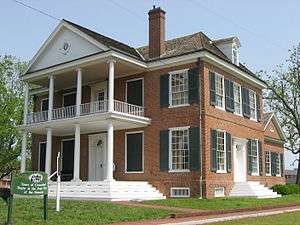Grouseland
|
William Henry Harrison House | |
 | |
| Location | 3 W. Scott St., Vincennes, Indiana |
|---|---|
| Coordinates | 38°41′7.76″N 87°31′33.62″W / 38.6854889°N 87.5260056°WCoordinates: 38°41′7.76″N 87°31′33.62″W / 38.6854889°N 87.5260056°W |
| Built | 1804 |
| Architect | William Lindsay |
| Architectural style | Federal Style |
| NRHP Reference # | 66000018 [1] |
| Significant dates | |
| Added to NRHP | October 15, 1966 |
| Designated NHL | December 19, 1960[2] |
Grouseland, the William Henry Harrison Mansion and Museum, is a National Historic Landmark important for its architecture and role in history. Grouseland is a large, two-story red brick home built for William Henry Harrison in Vincennes, Indiana, during his term as Governor of the Indiana Territory. The mansion was completed in 1804 and reportedly dubbed Grouseland by William Henry Harrison due to the abundance of grouse in the area.[3]
Grouseland was designed by the architect William Lindsay and constructed at great personal expense to Governor Harrison. The project was daunting: at the dawn of the 19th century, the territory had no established roads, and Vincennes itself had a population estimated at only 700. Nevertheless, Grouseland was built from local materials by skilled labor, and decorated in grand style with items imported from Europe. It is surmised by at least one biographer that Harrison's motives in constructing such a Xanadu in the wilderness included establishing the respect due to him as governor, despite his relative youth at the time. Grouseland served Harrison's position and marked his place in American aristocracy—William Henry was the youngest son of Benjamin Harrison, V, a signer of The Declaration of Independence.[4]
During Harrison's governorship of the Indiana Territory, Grouseland was the focal point of the social and official life of the territory. As the capital of the Northwest Territory, more territory was governed from Vincennes than any city outside Washington, D.C.[5] Grouseland was home to Harrison until 1812. It remained in the Harrison family until the late 1840s.
The mansion includes the council chamber where Harrison met with representatives from various American Indian tribes. In 1805, Harrison negotiated the Treaty of Grouseland with a number of important Indian leaders, including Little Turtle and Buckongahelas. Harrison had two confrontations with the Shawnee leader Tecumseh at Grouseland in 1810 and 1811 (see Tecumseh's War). Harrison's thirteen treaties with Native American leaders resulted in millions of acres of land being acquired by the United States.
Today, Grouseland is owned by the Daughters of the American Revolution who saved the building from destruction. It is overseen by the Grouseland Foundation, a volunteer board of directors composed of DAR and non-DAR members to manage the structure and programs. The main campus of Vincennes University is adjacent to the property, and other state historic buildings, such as the Territorial Capitol building, have been moved to the property.[6] It is located in the Vincennes Historic District.
References
- ↑ National Park Service (2007-01-23). "National Register Information System". National Register of Historic Places. National Park Service.
- ↑ "Grouseland (William Henry Harrison House)". National Historic Landmark summary listing. National Park Service. Retrieved 2008-07-23.
- ↑ Mendinghall, Joseph Scott (April 22, 1976). "National Register of Historic Places Inventory-Nomination Form: William Henry Harrison Home" (PDF). National Park Service. and Accompanying two photos
- ↑ Collins, Gail (2012). William Henry Harrison (First ed.). New York, New York: Times Books (Henry Holt and Company, LLC). pp. 3–4, 10. ISBN 978-0-8050-9118-2.
- ↑ Indiana Business Journal; link below
- ↑ http://www.spiritofvincennes.org/rendezvous/historic/
External links
| Wikimedia Commons has media related to Grouseland. |
- Official website
- 'Vincennes Hoping History Can Bring Tourism' Indiana Business Journal

